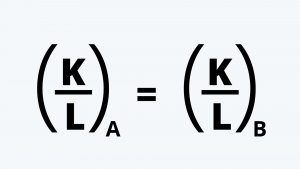Sources of Comparative Advantage
There are two models that discuss the sources of comparative advantage. The Ricardian model of comparative advantage focuses on labor as the source of comparative advantage, whereas the Heckscher–Ohlin model focuses on both labor and capital as sources of comparative advantage.
1.1. The Ricardian Model
a. This model is a refinement over the traditional model given by Adam Smith, which says that for a self-sufficient economy there is no need for international trade. This model goes further and discusses the benefits of comparative advantage for international trade.
b. According to this model, the countries specialize in the goods and services for which they have a comparative advantage.
c. The source of comparative advantage is labor productivity. Labor productivity is attributed to differences in technological advancements in different countries.
d. Countries trade because of differences in labor productivity gives them a comparative advantage over others.
e. The basic assumptions of this model are:
i. Labor is the only variable factor input.
ii. Technology varies across the countries.
f. Thus for countries A and B, producing two products X and Y:
i. If labor hours required to make product X by country A is more than the labor hours required by country B, then B will make product X.
That is, if ALX > BLX, then B makes X.
And, if ALY > BLY, then A makes Y.
1.2. Heckscher-Ohlin Model
a. According to this model, comparative advantages arise from different endowments of capital and labor.
b. Capital and labor are the two variable factors of productivity.
c. Countries trade because of different relative amounts of capital and labor. It is the efficiency of production that matters and a decisive factor as to which country will produce which product.
d. This model allows for income redistribution between owners and capital and labor through trade.
e. According to this model, if the capital to labor ratio in one country is more than the other country, it is the capital-abundant country. That is:
If,
Then, A is the capital-abundant country and B is the labor-abundant country. Thus if there is a product X, which is a capital-intensive product, then country A will produce it. And if there is a product Y, which is more labor-intensive than country B will produce it.
f. Two of the major assumptions of this model are:
i. There are identical technologies within industries across the countries.
ii. Both labor and capital are variable factor inputs.